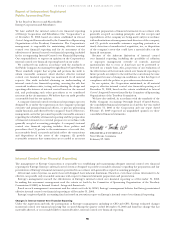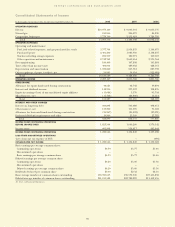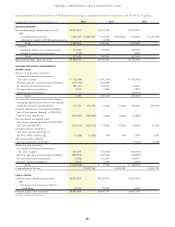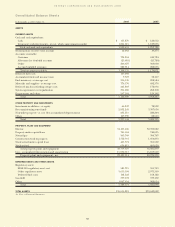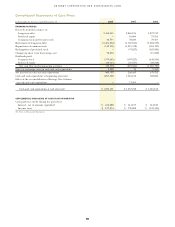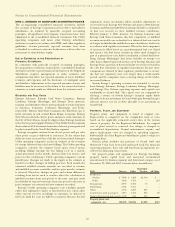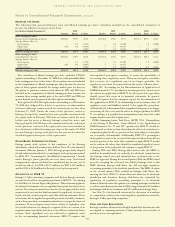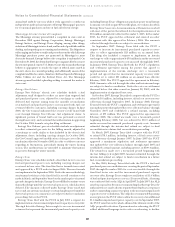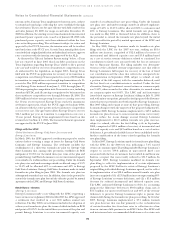Entergy 2008 Annual Report Download - page 67
Download and view the complete annual report
Please find page 67 of the 2008 Entergy annual report below. You can navigate through the pages in the report by either clicking on the pages listed below, or by using the keyword search tool below to find specific information within the annual report.6565
ENTERGY CORPORATION AND SUBSIDIARIES 2008
65
Notes to Consolidated Financial Statements continued
65
IN V E S T M E N T S
Entergy applies the provisions of SFAS 115, “Accounting for
Investments for Certain Debt and Equity Securities,” in accounting
for investments in decommissioning trust funds. As a result,
Entergy records the decommissioning trust funds on the balance
sheet at their fair value. Because of the ability of the Registrant
Subsidiaries to recover decommissioning costs in rates and in
accordance with the regulatory treatment for decommissioning
trust funds, the Registrant Subsidiaries have recorded an offsetting
amount of unrealized gains/(losses) on investment securities in
other regulatory liabilities/assets. For the nonregulated portion
of River Bend, Entergy Gulf States Louisiana has recorded an
offsetting amount of unrealized gains/(losses) in other deferred
credits. Decommissioning trust funds for Pilgrim, Indian Point 2,
Vermont Yankee, and Palisades do not receive regulatory treatment.
Accordingly, unrealized gains recorded on the assets in these trust
funds are recognized in the accumulated other comprehensive
income component of shareholders’ equity because these assets are
classified as available for sale. Unrealized losses (where cost exceeds
fair market value) on the assets in these trust funds are also recorded
in the accumulated other comprehensive income component
of shareholders’ equity unless the unrealized loss is other than
temporary and therefore recorded in earnings. The assessment
of whether an investment has suffered an other than temporary
impairment is based on a number of factors including, first, whether
Entergy has the ability and intent to hold the investment to recover
its value, the duration and severity of any losses, and, then, whether
it is expected that the investment will recover its value within a
reasonable period of time. See Note 17 to the financial statements
for details on the decommissioning trust funds and the other than
temporary impairments recorded in 2008.
EQ U I T Y ME T H O D IN VE S T E E S
Entergy owns investments that are accounted for under the equity
method of accounting because Entergy’s ownership level results
in significant influence, but not control, over the investee and its
operations. Entergy records its share of earnings or losses of the
investee based on the change during the period in the estimated
liquidation value of the investment, assuming that the investee’s
assets were to be liquidated at book value. In accordance with
this method, earnings are allocated to owners or members based
on what each partner would receive from its capital account if,
hypothetically, liquidation were to occur at the balance sheet
date and amounts distributed were based on recorded book
values. Entergy discontinues the recognition of losses on equity
investments when its share of losses equals or exceeds its carrying
amount for an investee plus any advances made or commitments to
provide additional financial support. See Note 14 to the financial
statements for additional information regarding Entergy’s equity
method investments.
DERIVATIVE FI N A N C I A L IN S T R U M E N T S A N D
CO M M O D I T Y DE RIVATIV ES
SFAS 133, “Accounting for Derivative Instruments and Hedging
Activities,” requires that all derivatives be recognized in the balance
sheet, either as assets or liabilities, at fair value, unless they meet the
normal purchase, normal sales criteria. The changes in the fair value
of recognized derivatives are recorded each period in current earnings
or other comprehensive income, depending on whether a derivative
is designated as part of a hedge transaction and the type of hedge
transaction.
Contracts for commodities that will be delivered in quantities expected
to be used or sold in the ordinary course of business, including certain
purchases and sales of power and fuel, are not classified as derivatives.
These contracts are exempted under the normal purchase, normal
sales criteria of SFAS 133. Revenues and expenses from these contracts
are reported on a gross basis in the appropriate revenue and expense
categories as the commodities are received or delivered.
For other contracts for commodities in which Entergy is hedging
the variability of cash flows related to a variable-rate asset, liability, or
forecasted transactions that qualify as cash flow hedges, the changes
in the fair value of such derivative instruments are reported in
other comprehensive income. To qualify for hedge accounting, the
relationship between the hedging instrument and the hedged item
must be documented to include the risk management objective and
strategy and, at inception and on an ongoing basis, the effectiveness of
the hedge in offsetting the changes in the cash flows of the item being
hedged. Gains or losses accumulated in other comprehensive income
are reclassified as earnings in the periods in which earnings are affected
by the variability of the cash flows of the hedged item. The ineffective
portions of all hedges are recognized in current-period earnings.
Entergy has determined that contracts to purchase uranium do not
meet the definition of a derivative under SFAS 133 because they do not
provide for net settlement and the uranium markets are not sufficiently
liquid to conclude that forward contracts are readily convertible to cash.
If the uranium markets do become sufficiently liquid in the future and
Entergy begins to account for uranium purchase contracts as derivative
instruments, the fair value of these contracts would be accounted for
consistent with Entergy’s other derivative instruments.
FA I R VA L U E S
The estimated fair values of Entergy’s financial instruments and
derivatives are determined using bid prices and market quotes.
Considerable judgment is required in developing the estimates of
fair value. Therefore, estimates are not necessarily indicative of the
amounts that Entergy could realize in a current market exchange.
Gains or losses realized on financial instruments held by regulated
businesses may be reflected in future rates and therefore do not accrue
to the benefit or detriment of stockholders. Entergy considers the
carrying amounts of most financial instruments classified as current
assets and liabilities to be a reasonable estimate of their fair value
because of the short maturity of these instruments. Effective January
1, 2008, Entergy and the Registrant Subsidiaries adopted Statement of
Financial Accounting Standards No. 157, “Fair Value Measurements”
(SFAS 157), which defines fair value, establishes a framework for
measuring fair value in GAAP, and expands disclosures about fair
value measurements. SFAS 157 generally does not require any new
fair value measurements. However, in some cases, the application
of SFAS 157 in the future may change Entergy’s and the Registrant
Subsidiaries’ practice for measuring and disclosing fair values under
other accounting pronouncements that require or permit fair value
measurements. See Note 16 to the financial statements for a discussion
of the implementation of SFAS 157.
IM P A I R M E N T O F LO N G -LI V E D AS S E T S
Entergy periodically reviews long-lived assets held in all of its
business segments whenever events or changes in circumstances
indicate that recoverability of these assets is uncertain. Generally,
the determination of recoverability is based on the undiscounted
net cash flows expected to result from such operations and assets.
Projected net cash flows depend on the future operating costs
associated with the assets, the efficiency and availability of the
assets and generating units, and the future market and price for
energy over the remaining life of the assets.
RI V E R BE N D AFUDC
The River Bend AFUDC gross-up is a regulatory asset that represents
the incremental difference imputed by the LPSC between the
AFUDC actually recorded by Entergy Gulf States Louisiana on a
net-of-tax basis during the construction of River Bend and what the
AFUDC would have been on a pre-tax basis. The imputed amount
was only calculated on that portion of River Bend that the LPSC
allowed in rate base and is being amortized through August 2025.


